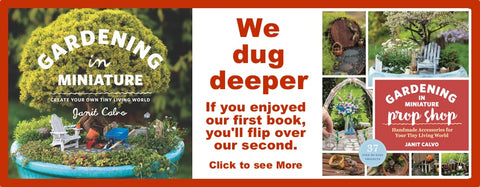Figuring out the light for your outdoor miniature gardens or fairy gardens can seem so arbitrary. I mean, what is part shade anyway? Only part of the garden is in shade? What is part sun? Which part of the plant would get the sun? Lol! I'm kidding! But you can see how it can be confusing at first. We are here to help!

Let there Be (Miniature Garden) Light
There is a formula that gardeners use to help you define what kind of light your outdoor garden receives so you can choose plants better suited for your garden. And no, you can't fool Mother Nature.
One of the most common mistakes a new gardener makes, is choosing plants for the wrong light - I've been there and I've done that.
Light matters. Too much light can scorch the plant's leaves, for example. Too little light, and they plant will either be reaching for more light, or gradually fade from existence. If you compromise the plant's basic needs, that's when you get bugs and moldy leaves. They are like us. If we don't get the right care and nutrition, we get sick.
Pay attention to what kind of light the plant needs and you'll have much happier and healthier plants because they won't get stressed out, they can naturally defend themselves from pests or diseases - which makes for a happy miniature gardener too. :o)

Our miniature and dwarf Mugo pines, as well as our mini and dwarf junipers, can both tolerate that hot-summer sun in the summertime. Pair these with any Sedum or our dwarf Hens and Chicks for a complete garden design - in miniature! This little guy is a Valley Cushion Mugo Pine that grows 2 to 3 inches (5 to 6 cm) per year.
The Right Light is Part of the Golden Rule, Right Plant in the Right Place
"Right plant in the right place," is the golden-garden rule and the very first step to take - even before you start thinking about looking at plants.
So what kind of light does that garden bed where you're planning to build a miniature garden receive?
Take notice of how many hours of direct sun your chosen garden bed receives, in the spring or the fall, then use the following light chart to help you define it.
Simple Light Chart for Planting Outdoors:
- Part shade - is 2 to 4 hours of cool sun.
- Full shade - is less than 2 hours of sun.
- Dappled shade - is called light shade or part shade.
- Part sun - is 4 to 6 hours of sun.
- Full sun - is 6 or more hours of sun.
- "Cool sun" - is morning sun before 11am or after 3pm, or in the winter.
- "Hot sun" - is from about 2pm to 7pm in the summertime.

But the Sun Moves Throughout the Year? How Does That Work?
So, you might be reading this in the middle of summer when the sun is at its highest and everything is in full sun, right? Yeah, ignore that. Take note of the amount sun in the autumn or the springtime to get the best "read" on it. Yes, your garden bed will be in full sun in the middle of the summer, but the plants can handle a little sun here and there - they just can't live full-time in full-sun if they are part-sun plants.
But it's as easy as figuring how what direction the light is coming from too. Check out this easy chart below.
- Eastern sun = cool sun
- Western sun = full sun
- Southern sun = full sun
- Northern light = part shade to full shade
So for example, if your backyard faces east, you know you are in cool sun or full sun. (This is one of my favorite light conditions for miniature gardening because just about every plant we carry will do well in cool sun! Yummy!)
NOTE that if there is a wall, garage, tree or your neighbor's house interfering with the light, that changes everything. Go back to the first chart to define your light.

What about Container Gardens?
Container gardens work the same way except you have the freedom to chose where the pot will go, of course. So FIRST you figure out where you want the pot to "live," then you can choose the plants to suit the light that that spot receives. Easy peasy!
Got any questions? Leave them in the comment box below.
Want a dose of miniature garden goodness delivered to your inbox every few days? It's free. It's also the ONLY one for the hobby. Lol! Join here - click into our main page and scroll down a bit for the form. TwoGreenThumbs.com


Hi Migdalia, The American Horticultural Society publishes the Heat Zone Chart that we use – we have heat zone information in all our plant listings for your convenience. You should be able to find that chart online but your southwest Florida area is Heat Zone 10 or 11.
I’m located in south west Florida, in zone 9b.
My biggest concern when choosing plants is heat tolerance which is not often provided in your info.